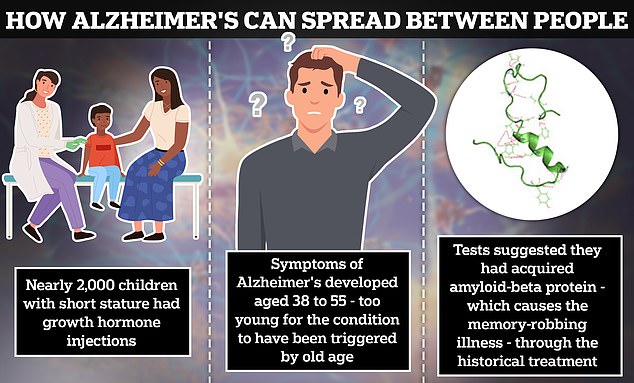NIH panel to launch urgent investigation amid evidence Alzheimer’s can SPREAD between people: Nearly 8,000 Americans received injection that transmitted memory-robbing condition
An NIH panel will convene an urgent meeting over fears that thousands of Americans are at risk of “getting” Alzheimer’s disease.
A British study published on Monday found that at least five people ‘contracted’ the memory-robbing disorder from a now-banned hormone treatment.
The growth hormones – extracted from the bodies of dead people – were littered with toxic amyloid beta protein ‘seeds’, or prions, which were shown to cause premature dementia.
Health experts in the US – where nearly 8,000 children were injected with the therapy between the 1960s and 1980s – the scares on this side of the Atlantic may have gone unnoticed.
A spokeswoman for the National Institutes of Health (NIH) told DailyMail.com: ‘Given this new information, the committee will meet to discuss the issue and reanalyze the data for possible associations with Alzheimer’s disease or dementia-related conditions .’
The US is preparing to reanalyze data to identify cases where patients have developed dementia at a young age after receiving the dangerous human growth hormone shots (Stock Image)
DailyMail.com understands the meeting will take place in early February between the public health agency’s Interagency Coordinating Committee on Human Growth Hormone and Creutzfeldt-Jakob Disease.
Plans were drawn up in the hours after the British investigation was released.
The panel will reassess US data for signs that patients who received the growth hormone injections developed Alzheimer’s disease.
Minutes from previous meetings show that the committee suspects that at least one American died of Alzheimer’s disease in his 60s after receiving the shot as a child.
If a link is found, it could potentially open the door to potential lawsuits.
In Britain, where 1,800 children received the shots, the government previously agreed to pay up to $380,000 (£300,000) to people who suffered from mental illness as a result of the shots.
The injections were administered between 1959 and 1985 to abnormally small children from the age of four.
They contained human growth hormone (HGH) harvested from the pituitary glands of cadavers to stimulate their growth.
The technique was subsequently banned and doctors used synthetic hormones instead after some batches were found to be contaminated with prions, leading to a fatal and incurable brain disease, Creutzfeldt-Jakob disease (CJD). CJD itself is closely related to ‘mad cow disease’.
Academics now believe that other medical and surgical procedures may pose a risk of spreading Alzheimer’s disease because prions – which build up in the brain and kill neurons – can survive sterilization methods in hospitals.
As prions build up in the brain, plaque deposits can appear in the brain.
Abnormal build-ups of proteins in and around neurons are thought to be the cause of Alzheimer’s disease.

Five patients were among 1,848 injected as children with growth hormones infected with toxic ‘seeds’ of amyloid beta protein. All five suffered from the same rare early form of the devastating dementia. Others who received the same treatment are now considered ‘high risk’
Of the 1,800 people in Britain who received the injections until 1985, at least 80 developed CJD, while at least five suffered from early-onset Alzheimer’s disease.
In the US, 35 cases of CJD have been discovered among the 7,700 patients who received the incorrect injections.
Experts say this is due to a change in the way the lampreys were manufactured in 1977, which led to an improved purification technique that filtered out dangerous proteins.
In the US, the shots were administered for research purposes through the National Hormone and Pituitary Program (NHPP), which was funded by the Department of Health and Human Services.
Doctors stopped using the hormone in 1985. when scientists discovered three cases of CJD among young men who had received the injections – and a link was suspected.
People currently receiving human growth hormone are not at risk of the complications because the hormone is now made by genetically modified bacteria in a laboratory, eliminating the risk of contamination with dangerous proteins.
The NIH spokeswoman added: “No data from the (US cohort) has suggested a link between cadaveric human growth hormone and Alzheimer’s disease.”
Alzheimer’s disease was previously thought to come in two forms: a ‘sporadic’ variant affecting thousands of people over the age of 65, which is by far the most common, and a genetic, early-onset disease that runs in families.
But the team at University College London in Britain that conducted the British study say they have now identified a third variant, which is slightly different from the others and very rare, and which can be spread from one person to another transferred.
UCL scientists were allowed to test whether batches of the infected growth hormone had been stored as a dried powder for decades.
They tested the decades-old powder on mice and found that it caused the production of Alzheimer’s-causing proteins.
